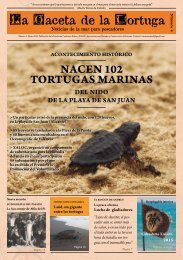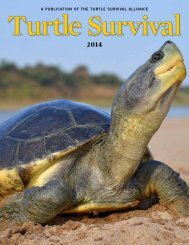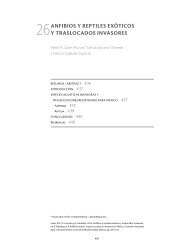tsrp63entire
tsrp63entire
tsrp63entire
Create successful ePaper yourself
Turn your PDF publications into a flip-book with our unique Google optimized e-Paper software.
5.3.5 Topic 18—Ex situ conservation techniques<br />
Three species of native frogs (Archey’s, Hochstetter’s and Maud Island) have been held in<br />
captivity since 2000 as part of a captive management research programme. However, the<br />
mortality rate of these frogs has been high. This was thought to be caused by a combination<br />
of factors relating to husbandry, particularly the control of MBD (see Shaw & Holzapfel 2008).<br />
Although several egg clusters have been produced by Archey’s frogs and Hochstetter’s frogs in<br />
captivity (Auckland Zoo, Hamilton Zoo, University of Canterbury), none have survived past the<br />
froglet stage.<br />
An additional barrier to captive breeding is the inability to physically identify male and female<br />
frogs. Although non-invasive sex identification techniques using hormone assays have recently<br />
been developed for native frogs (Germano et al. 2012), assisted reproductive technologies<br />
have not yet been used to increase the reproductive success and output of captive breeding<br />
populations. The development of artificial insemination and in vitro fertilisation are additional<br />
ex situ tools that could help to secure native frogs.<br />
To date, cryopreservation techniques for the storage of sperm and eggs/embryos have only been<br />
developed successfully for a few amphibian species worldwide. Such development is considered<br />
beyond the scope of this 5-year plan, but may become an important focus in the future.<br />
Issues<br />
Issue 18.1:<br />
Issue 18.2:<br />
Mortality rates in captive frog populations that have been established for breeding<br />
are very high.<br />
Captive frog populations that have been established for breeding have had very<br />
limited success.<br />
Objectives and actions<br />
Objective 18.1:<br />
Objective 18.2:<br />
To reduce mortality rates in captivity to natural levels (as identified in<br />
Action 16.1).<br />
To increase the reproductive success and offspring survival rates in captive<br />
breeding populations.<br />
Action Accountability Priority<br />
18.1 Review and, where required, refine husbandry<br />
techniques to reduce mortality in captivity for the<br />
duration of this plan.<br />
18.2 Review the diet (mineral and nutritional content) of<br />
captive frogs by analysing the stomach contents<br />
and faecal samples of wild frogs by 2015.<br />
18.3 Identify and provide an appropriate microhabitat in<br />
captive environments to maximise the success of<br />
captive breeding and juvenile survival by 2018.<br />
Recovery Group<br />
Captive institutions<br />
Recovery Group<br />
Captive institutions<br />
Recovery Group<br />
Captive institutions<br />
Essential<br />
Essential<br />
Essential<br />
32 Bishop et al.—Native frog recovery plan, 2013–2018





